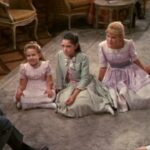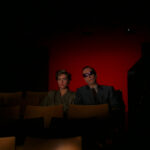****/**** Image A Sound A+ Extras B-
starring Max Records, Catherine Keener, Lauren Ambrose, Mark Ruffalo
screenplay by Spike Jonze & Dave Eggers, based on the book by Maurice Sendak
directed by Spike Jonze
by Walter Chaw Spike Jonze’s Where the Wild Things Are is the product of an artist who may only be able to assimilate art and the creation of it through the filter of celluloid and the music that animates its flickers. More, there’s the suggestion in its depth of emotion that this may be the only way Jonze knows to communicate at all, and so he tasks it to capture the breadth of human experience. If the “film brats” of the New American Cinema were the first reared on a diet of the French New Wave and critical theory, this new post-modernism to which Jonze belongs consists of artists reared on the entire panoply of popular culture…and maybe nothing else. What other explanation is there for the elasticity and strangeness of films by people like Jonze and Charlie Kaufman, David Lynch, Wes Anderson, and Quentin Tarantino? They create works that strive towards the ineffable, seemingly unaware of film’s limitations and therefore undaunted by ideas of what’s possible.
There are no extra words in Where the Wild Things Are, no monologues, no voiceovers, no explanations. There’s no help. Instead, there’s this crystalline adaptation of the beloved, minimalist, almost archetypal children’s book by Maurice Sendak that contains the same hidden depths, poses the same unanswerable questions, and ultimately provides the same measure of terrifying insight into children, parents, and the horror of growing up. Sendak has long been associated with Holocaust remembrance, and the film feels like prayers written on concentration-camp walls. In structure, it reminds of Nicholas Ray’s phantasmagoria of childhood’s end, Rebel Without a Cause, complete with protagonists in search of fathers, teachers preaching the end of times, broken families, and finally the tenuous handshake-restoration of society. But its subtlety–there’s not a syllable wasted along the way of a wondrously displacing use of image, coupled with a remarkable soundtrack (courtesy Karen O and Carter Burwell)–is equal parts haunting and exhilarating.
Max (Max Records) is a kid. He gets frustrated, he feels lonely, he gets mad, he feels sad. His mom (Catherine Keener–a specific muse for a particular kind of sadness) has her own frustrations, feels lonely, gets mad, feels sad. One night, Max tells Mom a story and she types it into her computer–and then they fight, and Max sails away over a year and a day and finds himself among the Wild Things. Of them, Carol (James Gandolfini) is almost as angry as Max and KW (Lauren Ambrose) is almost as sad as Mom, while the rest of them, voiced by a pantheon of fine actors (Chris Cooper, Forest Whitaker, Paul Dano, Catherine O’Hara), are each complex representations of causes and effects. Yet Where the Wild Things Are is different from The Wizard of Oz, not so easily explained away as projections of a disturbed psyche or some fantasy of escape. Jonze offers no platitudes to soften its waves of disturbance, regarding them instead with the appropriate terror. The Wild Things appear to have, indeed, eaten every child King preceding Max; their island lair is fraught with real menace. When they’re wounded they remain so, and when they build forts, they look exactly as improbably lovely as an Andy Goldsworthy ephemera.
Visually gorgeous, perfect in its way, Where the Wild Things Are leaves the lingering aftertaste of an intense, base savagery. It’s as elemental as children: capricious, furious one moment, loving, soft the next. As their King, Max moves his Wild Things to play at families and war (creation, then destruction), toying with what it’s like to have godlike powers and suffering human consequences in the wielding of them before arriving at a point that demonstrates the fleeting luxury of being small. It’s about being a kid. Given that Jonze and Dave Eggers wrote it, it probably shouldn’t come as such a surprise that its insights into the damages of growing up for kids and parents are as sharp as they are. There are moments of brilliance in this picture (a scene amongst miniatures; a moment after the war where Max learns about what happens when someone is hit with a rock; a farewell that reminds of the end of Jim Jarmusch’s Dead Man), but, really, the film from the first frame to the last is one extended tingle of recognition. This is exactly the sort of movie of which a vocal minority complains the American film industry is incapable, although Where the Wild Things Are is one of a kind, the rare work of art in any media that actually evokes the experience of sadness, the sensation of melancholy, the mechanism of regret. We’re lucky to have it. Originally published: October 16, 2009.
THE BLU-RAY DISCFor a film of such surpassing beauty to receive a commensurately beautiful Blu-ray presentation is one of the more gratifying developments in the early, already-triumphant days of the format. The 2.40:1, 1080p video transfer is astonishingly faithful to at least my theatrical experience of the picture, transporting DP Lance Acord’s autumnal palette with an intimate, almost textural fidelity. Where the Wild Things Are looks extraordinary in this incarnation, and many sequences are of reference quality. Max’s arrival, for instance, all shadows and firelight, would not initially seem like something one would cue up for skeptics, but the way that fire dances against an inky background… Pay attention to how those shadows flicker across the trees, then skip to the sequence with the giant dog for the photo-negative of this moment. The correct measure of softness in what is essentially a fable is preserved without interference from edge enhancement, while a breathtaking level of detail facilitates an appreciation of the wild things’ tangible presence–I could stare at Carol’s matted fur forever–and the intricate stick structures that are so much a part of their world. Only isolated incidents of crush in the night scenes late in the film prevent the image from receiving full marks. The 5.1 DTS-HD Master Audio track sounds, on the other hand, pretty perfect to my ear. Completely immersive, logically segmented and distributed, it inspired me to cue up immediately afterwards the rock-fight for a couple of surprisingly soft “whooshes” as rocks go whizzing by. When Max sails home, waves lap close in the rear channels. It’s really so very.
In the absence of a commentary, Warner provides Chris Lavis and Maciek Szczerbowski’s Higglety Pigglety Pop! Or There Must Be More to Life (24 mins.), a National Film Board of Canada adaptation of another Maurice Sendak story that richly deserves a review of its own. Meryl Streep voices the lead role of Jenny the dog, who finds herself in need of a home and “experience” so as to be accepted into the Mother Goose Theater Company. Said experience comes in the form of an assignment to feed a baby in a remote farmhouse–being sacrificed to the hungry lion (Forest Whitaker) in the basement the penalty for failure. Mixing puppets and CGI, the visual style falls somewhere between Jim Henson and Jan Svankmajer, although the tone is all Sendak in its menace and hostility. In fact, the whole thing is terrifying from start to end, with its moral that one should appreciate what one has delivered as less a cautionary tale than a cautionary example. Jenny’s unflagging optimism and, ultimately, her courage are all the more heartbreaking for how cruelly they’re rewarded. It recalls the best of “The Storyteller” (which is very good indeed)–and like the remaining supplements, it’s in HD.
“HBO First Look” (13 mins.) is a rushed but packed piece that introduces the mutual-appreciation society between Jonze and Sendak, which appears to be entirely genuine. It’s the soundbite herein that Sendak not only approved of Jonze’s take on his book but also thought he’d done something with it that was faithful to the spirit of his work that made me finally anticipate rather than dread this film way back when. A look at rehearsals and voice-recording sessions that had the actors interacting on a foam stage with microphones strapped to their head is shockingly revealing; James Gandolfini is a fucking genius. Sadly, the HBO featurette renders “Maurice and Spike” (3 mins.) redundant, as they’re culled from the same footage. Better is “Max and Spike” (7 mins.), detailing the intimate relationship that saw Max Records referring to Spike as his “second dad.” “The Records Family” (7 mins.) recaps the process that led to the casting of Records and includes snippets of the actor’s family participating in the production that either point the way to a healthy attitude towards Hollywood beckoning–or another Phoenix clan tragedy. “Carter Burwell” (5 mins.) is a relatively uninformative bit about the crafting of Burwell’s portion of the score; “The Absurd Difficulty of Filming a Dog Running and Barking at the Same Time” (6 mins.) is exactly what it sounds like; and “The Big Prank” (3 mins.) isn’t very funny but does suggest that the shoot was a good time. “Vampire Attack” (1 min.) has Jonze and Max goofing off by staging a vampire attack, and then there’s “The Kids Take Over the Picture” (5 mins.), recounting how Jonze encouraged cast and crew to bring their kids to horse around on set. A combination standard-def DVD/Digital Copy of Where the Wild Things Are occupies a second disc. Not usually a fan of such things, I confess I uploaded the film to my iPod.
101 minutes; PG; 2.40:1 (1080p/MPEG-4); English 5.1 DTS-HD MA, French DD 5.1, Spanish DD 5.1, Portuguese DD 5.1; English SDH, French, Spanish, Portuguese subtitles; BD-50; Region-free; Warner

![Where the Wild Things Are [Blu-ray]](https://m.media-amazon.com/images/I/51c7yCU-Y1L._SL500_.jpg)




